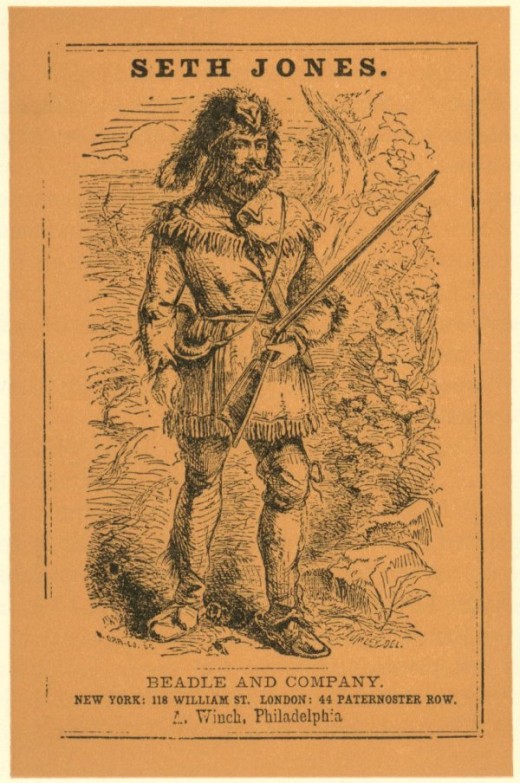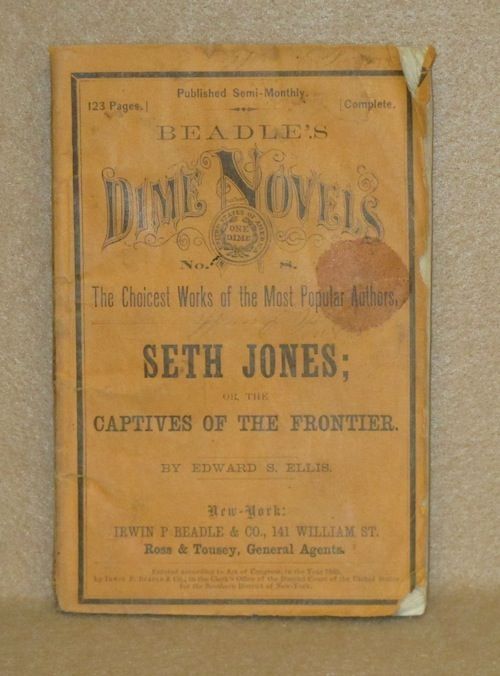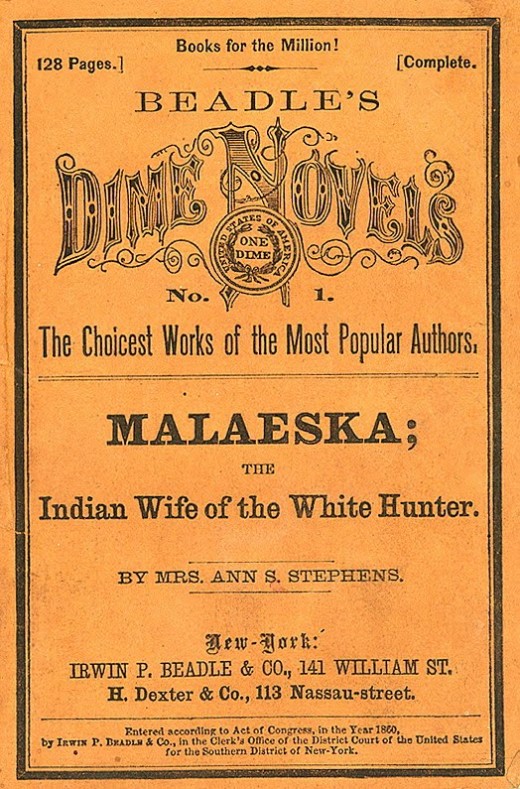- HubPages»
- Books, Literature, and Writing»
- Commercial & Creative Writing»
- Creative Writing
Captives of the Frontier (Short Story No.25)

Author's note
These short stories will be part of the sequel to my novel The Lady Who Loved Bones. Any suggestions for improvement or for future stories are welcome.

Seth Jones; or Captives of the Frontier
Sheriff Leslie Baxter, also known as Shorty, took Princess Takuhatahime, the circus snake charmer, with him to find her missing snake. He didn’t want to have to deal with the snake himself, not with a name like Beezelbub. Also, he wanted the princess to be readily available so that she could fulfill her end of the deal and perform the certain sex act she promised as soon as possible after the return of her snake. Robert Barnes, editor of the Helena Herald, went along because he thought it would be a good opportunity to get information for his dime novel. Pinkerton agents Helen James and Bob Wells joined the group going on the search. Sheriff Baxter was pleased to have them in view of their expertise with investigative techniques and weapons.
When they stopped to take a break, the talk turned to dime novels. Robert Barnes mentioned well-known dime novels he had copies of. In fact, he had several with him and pulled them out of his saddlebags. One was Maleaska, the Indian Wife of the White Hunter written by Ann Stephens and published in 1860. The other was Seth Jones; or, the Captives of the Frontier, written by Edward S. Ellis and also published in 1860, the first of the famous Beadle books.
The latter seemed to be of considerable interest, and Barnes summarized the story. Alfred Haverland and his family lived in a log cabin in the remote forests of New York. A stranger, Seth Jones, came to the cabin and warned the family of recent Indian attacks in the area. The Haverland’s daughter Ina is kidnapped by the Indians that night. Alfred Haverland and Seth Jones set off to track the Indians and retrieve the daughter. Everard Graham, Ina’s lover, and Ned Haldidge, an Indian scout, join the group. The group gets Ina back, and they try to make it back to the safety of a nearby settlement. They finally make it to the settlement after a few encounters with the Indians. Seth Jones then reveals his true identity.
“What was his true identity?” Helen asked after Barnes paused.
Barnes replied, “The old and eccentric hunter, Seth Jones, who had dominated the action in the book is actually the young genteel Eugene Morton in disguise. His sweetheart stopped caring for him while he was away fighting in the war, which apparently was the reason for his identity issues.”
Shorty glared at Helen and snorted, “At least Seth wasn’t a man disguised as a woman.”
Helen glared back and blurted, “At least Seth wasn’t a midget disguised as a sheriff.”
Robert Barnes, worried about an imminent physical altercation, stepped between them and showed them another dime novel. “This one is The Minnesota Captive: Josephine Huggins Story.” Barnes opened the book and read from it: “Taking an infant from its mother’s arms, before her eyes, with a bolt from one of the wagons, they riveted it, through its body, to the fence, and left it there to die, writhing in agony. After holding for a while the mother before this agonizing spectacle, they chopped off her arms and legs, and left her to bleed to death.” Barnes added, “This was the Indian Cut Nose who allegedly did this. The author of the book, Edward S. Ellis, made this up to sensationalize the work of fiction. Most of what’s in it is true; he got the information from ‘Adventures Among the Indians: Narrative of the Capture and Rescue of Mrs. Sophia Josephine Huggins’ as reprinted in the St. Paul Weekly Press on February 12, 1863 and V. D. Heard’s History of the Sioux War and Massacres of 1862 and 1863.”
Shorty said, “So what yer sayin’ is that these accounts of captives ain’t always the truth and nothin’ but the truth?”
“Exactly,” Robert Barnes confirmed. “Authors of these dime novels sometimes fudge the truth about these captives and the brutality of the Indians to sell books.”

Matilda Lockhart, Comanche captive
“Ranger Bob,” Shorty said to Pinkerton agent and former Texas Ranger Bob Wells, “Tell them your story about Matilda Lockhart and all that.”
Wells did. He reported that his father had often spoke of when Matilda Lockhart in 1840, then sixteen years old and a Comanche captive for some time, had been taken by the savages to the Council House in San Antonio to be exchanged for peace treaty concessions. His father had been present and heard Matilda talk of her rape, humiliation, and torture. Her nose had been burnt off to the bone and her entire body, which she revealed, scarred with burns all over.
When Matilda told of 15 other captives who had been similarly treated, the Texans announced to the Comanche present that they would be detained until the others had been rescued. A fight ensued and 35 Comanche were killed, many more injured, and 29 taken prisoner. When the Texans offered to swap the 29 prisoners for the white captives, the Comanche tortured every one of the captives. The young women and children were staked out by a fire, skinned, mutilated, and burned alive. Matilda’s six-year-old sister was one of the victims.
Back in 1854, Wells’ family had a ranch near Austin. He and his father and older brother were out hunting one day when a Comanche raiding party swooped down on the rest of the family, his mother and two sisters. He would not be specific in describing the horrific scene when the father and sons returned.
A year after that, Wells joined the Texas Rangers, a mere lad of 17. He lied about his age, and with a scruffy beard and powerful frame, did look considerable older. He served with the Rangers until after the war, exacting no small measure of revenge on the Comanche, but they would never be even as far as he was concerned.
In 1861 his best friend and fellow Ranger, Norm Randle, was captured by the Comanche and taken to their nearby camp. Among other things, the squaws castrated him, while he watched. They cut out his tongue to quiet his screaming. Norm lived to tell the story of how the squaws put seasoning on his testicles and then ate them. Well, not tell exactly tell. Since Norm didn’t have a tongue, nobody could understand him, but he could write. He wrote it down. Then a few months later he hung himself. His sweetheart, a beautiful redheaded Irish lass, didn’t want much to do with a suitor who had no balls and no tongue.
When Wells paused Shorty interjected, “And then Ranger Bob told Boyd, who had gotten his tongue cut off by Johnny Blackfoot, ‘See there, Boyd, you’re damn lucky you only got your tongue cut off and not your balls.’ Johnny Blackfoot wasn’t too lucky hisself since he got his head cut off by Sweet Water, the Arapaho princess.”
# # #

Naked and afraid
The Porter brothers, Red and Blackie, arrived at Captain Taz’ hideout north of Fort Smith along the Big Horn River. The hideout was an abandoned ranch now occupied by Crow horse rustlers.
“They sure got funny looking hair,” Blackie said to Red. The hair of the men was long, in many cases dragging on the ground with part styled into a pompadour.
Blackie and Red got the whiskey from their wagon, showed it to the Crow, and offered to trade the whiskey for the two captives, Hannah Monroe the paleontologist and Sweet Water, the Arapaho princess. At first Blackie and Red thought the two captives were dead because they were comatose, but the Crow assured them that was because the women had been drugged so that they did not attempt to escape. The Crow also assured the Porter brothers that the women had not been raped or otherwise brutalized. They had been stripped naked on occasion and forced to dance as a source of amusement the Crow reported.
# # #
Shorty and the others read from Robert Barnes’ collection of dime novels as they ate dinner. Looking up from his reading Shorty said, “I’m writing my own dime novel about that paleontologist Hannah Monroe and every word is the damn truth. It starts with on the very first page: ‘Hannah shook her head to chase the flies from her face. She couldn’t very well swat them with her hands. The flies had begun to swarm around the bloody bodies and the vultures circled overhead. She shivered uncontrollably, and not because it was cold. No indeed, it was a hot sunny day in the late spring of 1867 in that remote part of the Montana Territory along the Bozeman Trail. The Cheyenne warrior, a fatal wound in the middle of his back, fell across the naked woman restrained to the tree.”








